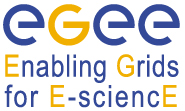Speaker
Report on the impact of the activity, tool or service. This should include a description of how grid technology enabled or enhanced the result, or how you have enabled or enhanced the infrastructure for other users.
The EGEE grid infrastructure and middleware is providing a foundation layer on top of which to build neurosciences applications. However, the gap between the low level functionality provided (batch processing, distributed files management...) and the applications requirements (data flows processing, medical data representation...) is large. The NeuroLOG project aims at fostering the adoption of HealthGrids in a distributed pre-clinical community. It is adopting a user-centric perspective to meet the neuroscientists expectations. The tools and methodology enable the integration of heterogeneous site data schemas and the definition of a site-centric policy. The NeuroLOG middleware bridge the EGEE grid and local resources to provide a transitional model towards HealthGrids which is respective of users desires to control resources and data. The NeuroLOG middleware is currently used to enact an application to Multiple Sclerosis patient population analysis on the EGEE grid.
Describe the activity, tool or service using or enhancing the EGEE infrastructure or results. A high-level description is needed here (Neither a detailed specialist report nor a list of references is required).
Neuroscientists are manipulating large image data sets and complex collections of medical data. They are consumers of computing infrastructures to execute complex image analysis pipelines. In the context of the NeuroLOG project, tools and methods are deployed on top of gLite to ease the exploitation of the EGEE grid in neurosciences. The developments target medical data representation, data sets federation, secure storage, image analysis software deployment and grid workflows enactment.
Describe the added value of the grid for your activity, or the value your tool or service adds for other grid users. This should include the scale of the activity and of the potential user community, and the relevance for other scientific or business applications.
NeuroLOG specifically targets three neurological pathologies: brain strokes, brain tumors and multiple sclerosis. The project provides a brain medical image ontology and a metadata schema designed to represent information concerning the target pathologies. It proposes a middleware architecture by integrating existing tools (MOTEUR workflows enactor interfaced to the EGEE Grid, CORESE semantic query engine, Data Federator databases federation tool, etc) and developing missing components to address the requirements of neuroscientists. It targets the integration of data resources coming from 5 medical centers. It aims at providing a demonstrator by the end of the project (2010) that federates hundreds of data sets (hundred of GBs of data) and that can exploit the grid infrastructure to process 4 different neurological data analysis pipelines. The workflow processing engine will be interfaced to the data representation and query system to identify the data sets to be processed.
